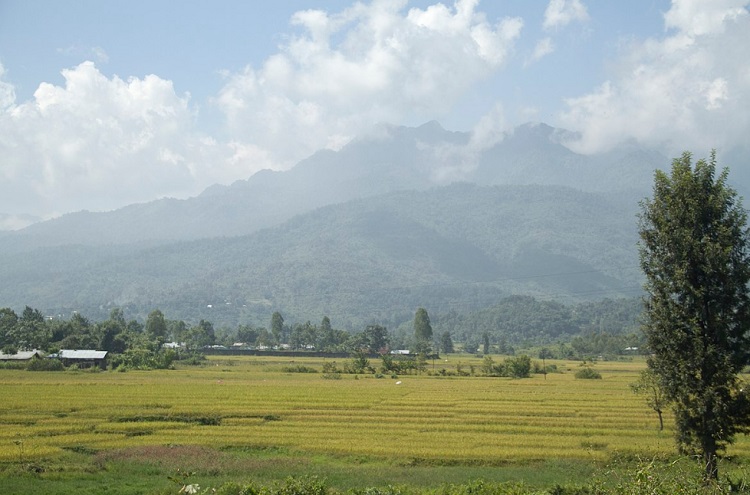Northeast India, often known as the Seven Sister States, is made up of undulating hills, rolling valleys, and peaceful hamlets. Arunachal Pradesh, Meghalaya, Assam, Manipur, Nagaland, Tripura, and Mizoram are the seven Indian states that make up the region. Sikkim the most recent addition, has become the eighth state in 2002.
These sites, which are rich in vegetation and fauna, are off the beaten path and away from the tourist trail. There is a wide range of history, culture, and traditions, all of which are deeply rooted in the past. Every destination is a piece of heaven, with friendly residents eager to greet guests.
The natural beauty of India’s North-Eastern states has always been talked about and kept hidden by nature. From the cleanest village in Asia to India’s oldest oil refinery in Assam, the states have a lot to offer.
Seven Sisters of India
The seven sisters are mostly separated by international borders. The Tawang Monastery, India’s largest monastery, is located in Arunachal Pradesh, while Mawsynram, Meghalaya, has the world’s greatest average rainfall. Do you know about India’s undivided dynasty, which ruled for nearly 600 years? Well, that’s the gist of it, and you’re invited to learn more about the Seven Sisters and their Only Brother.
The significance of the seven sisters can be traced to their long-standing customs and culture. These customs are mirrored in the festivals that they hold.
Assam

Assam, the tea state, is nestled between the majestic kingdom of Bhutan to the north, the land of the rising sun Arunachal Pradesh to the south, the abode of clouds Meghalaya, the Land of Festivals Nagaland, the Jeweled land Manipur, the songbird of India Mizoram, and Tripura to the north.
Assam is home to the enormous Brahmaputra River, which originates in the Himalayas. The Brahmaputra River, with its 1000-kilometre length, is renowned as Assam’s “lifeline,” as its water supplies twenty-two districts, five national parks, and twenty animal sanctuaries. There are almost 900 different types and birds on this island.
A huge portion of Assam is covered in lush tea farms, and seeing these plantations is a must for any traveller. This region’s natural beauty is unrivalled, and it offers a lot of promise for satisfying wanderlust.
It is also home to the Kamakhya Temple, one of India’s oldest pilgrimage sites, which attracts innumerable pilgrims from all across the country.
Places to visit in Assam
- Digboi is an old Assamese city that is home to India’s first oil refinery.
- Witness the extinct one-horned rhinoceros and other wildlife species at the Kaziranga wildlife sanctuary.
- Haflong, also known as the ‘Ant Hill Town’ or the ‘Switzerland of the East,’ is Assam’s sole hill station.
- The Majuli is the world’s largest river island. The transboundary river the Brahmaputra surrounds it.
- Sualkuchi, sometimes known as the “Manchester of Assam,” is known for producing the best silk in the country.
- Visit Dibrugarh, Assam, to sample some of the world’s highest-quality teas.
How to reach Assam?
By Air: The Lokpriya Gopinath Bordoloi International Airport, as well as the airports in Dibrugarh, Jorhat, Silchar, Lilabari, and Tezpur, serve Assam.
By Train: The Guwahati Railway Station is the closest.
Arunachal Pradesh

Arunachal Pradesh is India’s least explored state, and it is wild and unspoiled. Snow-capped peaks, emerald green woods, and rushing streams look like they came straight out of a postcard. There are 26 indigenous tribes in Arunachal Pradesh, as well as over 500 exotic bird species.
Scheduled tribes make up the majority of the region’s tribes. The Adi tribe, which is the state’s largest, is joined by the Nissi, Apa Tani, Hill Miri, Sherdukpen, Aka, and Monpa tribes. Arunachal Pradesh is one of Asia’s most linguistically varied areas. There are thirty to fifty different languages and dialects spoken there. Itanagar is the state capital of Arunachal Pradesh.
It’s no surprise that it promises guests unforgettable adventures. This area is all about the unadulterated natural beauty that can’t be found anyplace else. Inhale the mountain air or seek consolation in the peaceful surroundings; this area has it all to help you relax.
Places to visit in Arunachal Pradesh
- Visit the Sessa Orchid Sanctuary and Pakhui Wildlife Sanctuary, or go hiking in the Bhalukpong Hills.
- Pasighat is Arunachal Pradesh’s oldest town.
- The Brahmaputra River, which originates in Tibet, travels through this region.
- Visit the Sessa Orchid Sanctuary and Pakhui Wildlife Sanctuary, or go hiking in the Bhalukpong Hills.
- The Tawang Monastery in Tawang is the country’s oldest and largest monastic complex.
- Talley Valley Wildlife Sanctuary is located in the Ziro Valley. Every year in September, Ziro presents the wonderful and engaging Ziro music festival.
How to reach Arunachal Pradesh?
By Air: The nearest airport is Lilabari Airport, which is only 57 kilometres from Itanagar.
By Train: The Harmuti train station is the closest station connecting Arunachal Pradesh to other major Indian cities.
Nagaland

In the southeastern region of Nagaland, it has borders with Assam, Arunachal Pradesh, and Myanmar. Nagaland’s capital is Kohima. Evergreen woods cover a significant portion of Nagaland. Palm trees, bamboo trees, rattan trees, and mahogany trees, as well as sambar deer, wild oxen, buffalo, bears, leopards, tigers, elephants, foxes, five cats, mongooses, and monkeys, are just a few of the species that can be found in vast numbers.
For food and jobs, Nagaland is heavily reliant on agriculture. Agriculture employs ninety per cent of Nagaland’s people. Only cottage enterprises existed in the state until the early 1970s.
The state’s main crops are rice, maize, legumes, oilseeds, sugarcane, potato, and tobacco.
The Ao Naga tribe celebrates the Moatsu Festival, which is one of India’s most important and well-known festivities. The main purpose of this celebration is to seek God’s blessings and provide entertainment for the tribe after a long day of sowing seeds, clearing wells, and restoring houses.
Places to visit in Nagaland
- Dimapur is the state’s major city. The magnificent ruins of the citadel Kachari Rajbari are a must-see national historic site.
- The Kohima War Cemetery is located in Kohima, Japan. It is a World War II memorial honouring servicemen who fought the Japanese forces. If you visit Kohima in December, be sure to attend the Hornbill Festival, which is a large-scale celebration.
- Tribe of Lotha Pesticide- and fertilizer-free oranges and pineapples are famous in Wokha.
How to reach Nagaland?
By Air: Nagaland is 75 kilometres away from the Dimapur airport. Guwahati and Kolkata are both easily accessible from Dimapur.
By Train: Dimapur is the closest railway station.
Meghalaya

The majority of Meghalaya is covered in hills and thick forests, which remain drenched for the majority of the year due to regular showers, which provide a pleasant chill in the air. Meghalaya’s official language is English. Also spoken are Khasi, Garo, Bengali, Nepali, Hindi, and Assamese. Meghalaya is known for its annual Wangala celebration, which takes place in November. Autumnal Festival, Strawberry Festival, and Ranikor Festival are some of the other Meghalaya events.
Shillong, Meghalaya’s capital, is a hill station. Shilong’s structures and monuments are heavily influenced by British architecture. Shillong is known as the ‘Scotland of the East,’ as it is surrounded by clear turquoise lakes and falls.
Ka Pomblang Nongkrem, also known as Shad Nonhkrem, is one of India’s most vibrant festivities, taking place in November. Goddesses Ka Blei Synshar is revered by the tribal tribes of Meghalaya for a prosperous and good crop. The festival is mostly observed by Meghalaya’s Khasis tribe.
Places to visit in Meghalaya
- The Mawlynnong waterfall and the living root bridge are well-known tourist attractions. It is also known as “God’s Own Garden.”
- The Elephant Waterfall are three levels of the north-most east’s famous falls.
- The Cherrapunji Double Decker Living Root Bridge is a 3 km long and 2400 feet high man-made bridge.
- The Nohkalikai Falls are the world’s fourth-highest waterfalls.
- The government of Meghalaya established the Balpakram National Park in the Garo Hills in 1986 for the conservation of the state’s flora and fauna.
How to reach Meghalaya?
By Air: Shillong or Umroi Airport, 30 kilometres from Shillong, is the nearest airport.
By Train: There are no railway stations in Meghalaya. The closest railway station to Meghalaya is Guwahati, which is 104 kilometres from Shillong.
Mizoram

Mizoram, nestled in the rugged landscape, is the home of the Mizos, the indigenous people. This region, which is dotted with lush woods and rich with wildlife, is a haven for nature lovers and adventure seekers alike. Bangladesh and Myanmar share Mizoram’s borders.
Mizoram, with its vibrant festivals and idyllic surroundings, is one of our country’s lesser-known provinces. One of Mizoram’s numerous attractions is the intricate craftsmanship of indigenous artists. Mizoram is famed for its traditional gastronomy, which is a true delight for the taste buds, in addition to its picturesque splendour. It’s no surprise that the beauty and grandeur of this state will never cease to astound you.
Champhai, Mizoram’s eccentric and quiet town, is a delight for all. Champhai, also known as Mizoram’s Rice Bowl, is famed for its lush green rice fields that are farmed in a step-by-step fashion. This lovely and quaint hill station is one of the most beautiful sites in the northeast, boasting the Tiau Lui River, Rih Dil Lake, and Kungawrhi National Park.
Places to visit in Mizoram
- The ‘House of Gods’ is known as the Phawngpui Hills. It is Mizoram’s highest mountain summit.
- The town of Thenzawl is a small one. Travel back in time to a more tranquil and charming era on the slopes.
- Mizoram’s caves, Khuangchera Puk, are famed for being the state’s longest cave. It measures 162 metres in length.
- The Vantawang Falls, located near Thenzawl, are Mizoram’s highest and most magnificent waterfalls.
- The Chhingpui Memorial was created as a symbol of Chhingpuii and Kaptluanga’s love.
- The Phawngpui or Blue Mountain National Park is one of Mizoram’s most popular hiking and camping destinations.
How to reach Mizoram?
By Air: The best option is to take a taxi from Aizwal Airport. Kolkata, Guwahati, and Imphal are all well-connected from the airport.
By Train: The nearest railway station is at Agartala, which is 145 kilometres away.
Tripura

Tripura is India’s third smallest state. The Tripuri dynasty ruled Tripura for several centuries. Under the British Empire, it was part of an independent princely state. In 1949, the sovereign state of Tripura was annexed by Independent India.
This state’s capital is Agartala. Agartala is one of Tripura’s most fascinating cities, rich in natural beauties and home to many native tribes, heritage monuments, and temples. In addition to Ujjayanta Palace, Kamalasagar, Neermahal Palace, Gandacherra Wildlife Sanctuary, and Kalapana Nature Park, visitors to Agartala can visit Ujjayanta Palace, Kamalasagar, Neermahal Palace, Gandacherra Wildlife Sanctuary, and Kalapania Nature Park.
This region, which spans over 10,000 square kilometres, is known for its rugged topography and tribal settlements placed in a beautiful backdrop. Tripura is home to 19 indigenous tribes and has a distinctive and peculiar culture.
Everyone lives in peace and harmony in this region, which is a combination of tribal and Bengali cultures. Tripura has something for everyone, from sightseeing to trekking and delectable cuisine. Ujjayanta Palace, Sepahijala Wildlife Sanctuary, Chittagong Hills, Tripura Sundari Temple, and others are among the prominent tourist attractions.
Places to visit in Tripura
- The Tripura Government Museum was founded in 1970 to display pieces of Tripura culture and history through carvings and antiques.
- The Sepahijala Wildlife Sanctuary is a research and academic facility.
- The Ujjayanta Palace is a royal palace with sophisticated and beautiful architecture, as well as manmade lakes, melodic fountains, and a green area.
How to reach Tripura?
By Air: The Maharaja Bir Bikram airport is located in Agartala. Kolkata and Guwahati are both easily accessible.
By Train: Kumarghat railway station, 140 kilometres from Tripura, is the closest.
Sikkim

Bhutan, Nepal, and West Bengal form its borders. After Goa, Sikkim is India’s second-smallest state. Sikkim is known for having India’s highest peak, Kangchenjunga, which is also the world’s third-highest mountain. The Namgyal dynasty founded Sikkim, which was controlled by a Buddhist priest.
Under British authority, it was incorporated as a princely state. The royal system of governance was dissolved in 1975, making Sikkim India’s 22nd state. Sikkim is one of India’s fastest-growing states.
Sikkim’s economy is heavily reliant on agricultural production. Sikkim has India’s third-smallest yet fastest-growing GDP in 2014.
After Guatemala, it is the world’s second-largest producer of cardamom. Sikkim accomplished significant success in 2016 when it converted all of its products to organic. It is the only Indian state to have achieved this feat. It has also succeeded in outlawing the use of plastic bottles and polystyrene items, establishing itself as one of India’s most environmentally conscious and responsible states.
Sikkim is a state that speaks a variety of languages. English, Nepali, Sikkimese, and Lepcha are the state’s official languages. Gangtok, Sikkim’s largest city, serves as the state’s capital.
Places to visit in Sikkim
- In Sikkim, the Khangchendzonga National Park is both a National Park and a Biosphere Reserve. It was included on the UNESCO World Heritage List in 2016, making it India’s first mixed heritage site.
- The Namgyal Institute of Tibetology houses centuries-old Tibetan and Buddhist objects that have been carefully conserved.
- The Rumtek Monastery, perched atop a Gangtok hill, is one of Sikkim’s largest and most important monasteries.
- Tsomgo Lake, also known as Changu Lake, is one of India’s rare high-altitude lakes. The Gangtok – NathuLa highway, is located.
- The Nathu La pass, located in the Himalayan ranges, is one of the most important routes connecting Sikkim and China.
How to reach Sikkim?
By Air: The nearest airport to Sikkim is West Bengal’s Bagdogra Airport, which is approximately 124 kilometres from Gangtok.
By Train: The Siliguri railway station, located 114 kilometres from Gangtok, is well connected to India’s major cities.
Manipur

Manipur, one of India’s least visited states, boasts a plethora of tourist attractions that never fail to impress visitors. It’s renowned as the ‘Land of Jewels,’ and it welcomes guests with abundant natural beauty. Manipur is a seamless blend of lush green hills, dense forests, serene lakes, and breath-taking scenery.
Manipur greets visitors with lush greenery and a pleasant temperature. It is densely packed with ancient structures and temples, in addition to natural attractions. One of the largest temples dedicated to Lord Krishna and Devi Radha is Shri Govindji. Make sure to attend the renowned Sangai Festival, which delves into Manipur’s true culture and heritage.
Imphal, Manipur’s capital, is one of the top educational hubs among the Seven Sisters of India’s capitals. Imphal is a site of meandering rivers, lush green valleys, lakes, and foggy mountains, and is one of the most beautiful places in the Seven Sisters States.
The largest freshwater lake in India, Loktak Lake, is a sight to behold, while the ancient Kangla Fort displays the rich culture and history of a bygone era. Without a doubt, this northeastern metropolis is one of the top destinations to visit in Manipur.
Places to visit in Manipur
- The Loktak Lake is the world’s only floating lake.
- The only floating refuge in the world is Keibul Lamjao National Park.
- The Singda Dam is the world’s highest mud dam, and it’s a great place to go for a climb, a trek, or just a relaxing day in the park.
- The bronze statue of Subhash Chandra Bose is a highlight of the INA Memorial Complex.
- The Ima Keithel Woman’s Market has been around for about 500 years. Thousands of female vendors sell a wide range of fabrics, jewellery, and food.
How to reach Manipur?
By Air: After Guwahati Airport, Bir Tikendrajit International Airport is the second-largest and busiest airport in the northeast. Manipur is a 31-minute drive away.
By Train: Imphal does not have a direct train service. You might travel to Guwahati or Dimapur before continuing to Manipur.



































